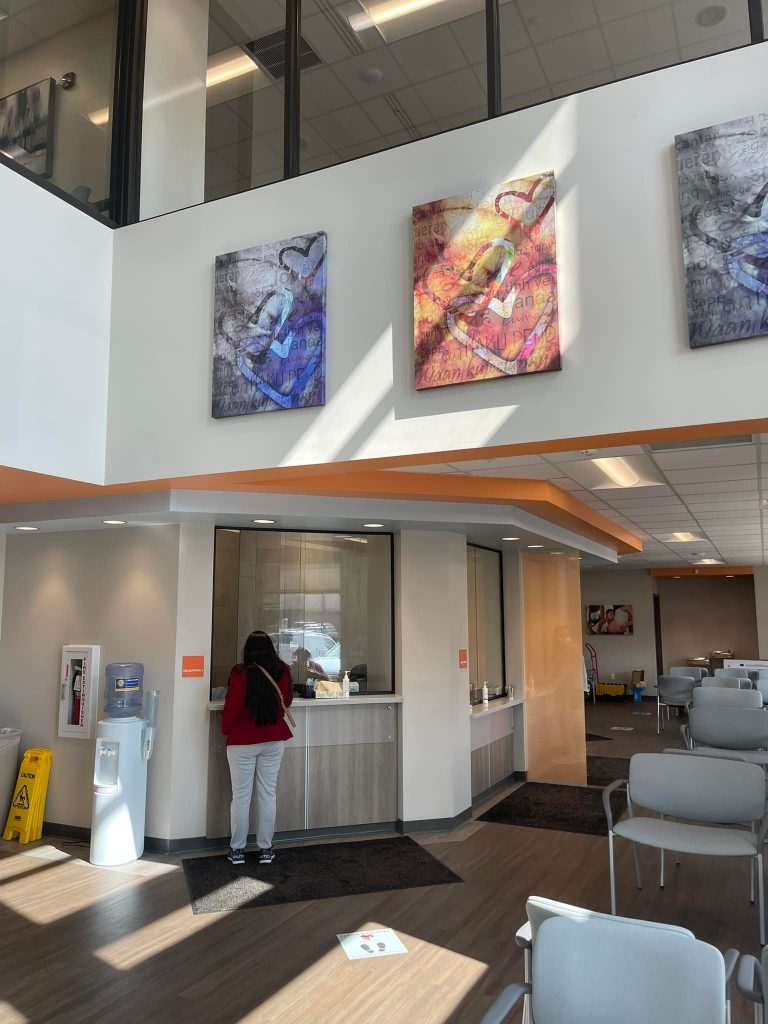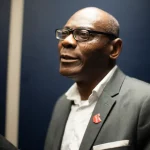After excelling in highly revered subjects like Physics, Chemistry, Mathematics, in A Levels at the Presbyterian Science College ( PRESEC), Lagon, Accra, Ghana, Dr. Buhari Mohammed, the CEO of the Heart of Ohio Family Health Centers, a Federally Qualified Health Center, or Community Health Center based in Columbus, Ohio knew then that his calling was in medicine. The nurturing from Ege University, where he graduated as Doctor of Medicine, to University of Kansa where he became a Fellow in Community Health Executive Management, and an MBA from Capital University, Columbus, Ohio prepared him for the CEO of Heart of Ohio Family Health Centers, coupled with almost 23 years in the system of federally qualified health centers.

Heart of Ohio Family Health Centers receives some federal funding from the government to provide primary health care to all residents without the restriction of whether they have insurance or don’t have insurance. “We are able to provide them with care regardless of their ability to pay and regardless of their status in this country,” Dr. Buhari Mohammed told the Editor of the New Americans magazine, Deba Uwadiae in an interview at the clinic’s East Main complex, Columbus, Ohio. Prior to leading Heart of Ohio Family Health Centers, which he joined five years ago, he had worked at another community health center in central Ohio for 16 years.
Federally Qualified Health Center
Federally Qualify Health Center or the Community Health Center started in the United States in 1965. This concept, which is a very unique way of providing care is called a community based health care. It was a concept developed, of all places, in Africa, in South Africa precisely in the 1940s. In the 1940s there was a couple, Sidney, and Emily Kark, who developed this program called The Community Oriented Medicine. They were the physicians that developed it in South Africa and were of Jewish background. They developed this community oriented medical care in the Pholela region in South Africa.
They went to this region and decided that medical care should be community based, which is, when somebody is sick, you look at something they call social determinants of health, that is how the person got sick, to address the disease and social construction of what causes the person to get sick. That is a unique way of looking at medicine. In the past, you went to the doctor, and they gave you a prescription. And that is! But here, the Karks were looking at the food you eat, the water you drink, the environment you’re sleeping in, and then your level of education as part of a health care delivery.
United States
There was a doctor called Dr. Jack Geiger who went to South Africa to intern with the Karks in the 1950s. He came back to the United States, and he started to practice, but in the 60s Dr Geiger was involved in the Civil Rights movement. Down south, during the freedom right in 1963, he was the physician that was treating the civil rights people who were being beaten, chased, and wounded. He will be treating them. So, at that moment he said he wanted to use what he saw in South Africa, the concept of community oriented medicine to fight poverty.
And in the 60s also, President Lynden B. Johnson declared war on poverty. So. Dr Geiger applied to the government of the US to fight poverty using healthcare. He applied for $30,000 and they gave him $300,000. He was able to build two clinics, one in Boston Massachusetts in 1965. and at the same time, one in the Mississippi Delta region. These two health centers grew into a whole lot of other activity of health centers, and the concept was to use what he saw in South Africa, where social determinant of health is critical.
Government Policy
In 1975, the federal government seeing how this clinic Is performing passed the 330 Act to make it as a permanent federally qualified community health center grant receivable in a system created to take care of everybody in the community. You don’t turn anybody away, regardless of the inability to pay, regardless of the insurance, regardless of their immigration status. You must see everybody. In1975, the government made it a permanent funding program.
As at today, there are almost about 1,500 of federally qualified health centers throughout the United States. And we have more than 8,000 sites throughout the United States, and as of last year, we saw 30 million people throughout the United States.
20years of Heart of Ohio Health Centers
Heart of Ohio Family Health Centers is one of the federally qualified health centers and had joined since 2003, making it 20 years this year. This is a movement; it is a movement of health care delivery for the whole entire community regardless of who the patient is, where they came from, the language they speak, the insurance they have and their ability to pay.

I joined the Heart of Ohio Family Health Centers in April 2018. And when I joined the Heart of Ohio Health Centers, we had only two clinics serving about 7,000 patients with 65 dedicated medical staff. There was one other clinic that was not faring very well then. So, what we decided to do since then was to just rebound the operation and the access. Today we have six clinics in Fraklin County serving almost 20,000 patients with almost 190 dedicated medical staff. For three years in a role, the federal government has recognized us as Health Center Quality Leader!
Primary Health Care
There are people who go to ER, Emergency Room for their primary care. If they had access to primary care they wouldn’t go to ER for their primary care, like if they’re suffering from diabetes, hypertension or checkup, immunization, or something like that. It costs you and I, who pay taxes, a lot of money to take care of people like that in the emergency room. Access has been my main issue to try to improve; how do I expand access for people to come to primary care. Expanding access was a big visionary that I wanted to accomplish; expanding access to people to come to an affordable, quality health care.
My mission then was how to expand the services from two to where we are right now, five years later. I began by looking at the operation, because I have experience, almost 16 years’ experience in another entity which was bigger. I started looking at the operation to improving and decided to go after the low hanging fruits such as enhancing and improving the 340B program to boost revenues, enhance patients encounters and fixing the billing side of the business.
We did well in looking at our patients based on the revenue that is coming in. When it happened that way, we started to expand to increase access.
Canal Winchester
The first expansion was to move the clinic that was not faring well. It was actually created in a housing complex. It was called Chantry. The National Church Residences has a housing complex, and the clinic was there, and nobody was utilizing it. The residents were not utilizing it and the community was not utilizing it. I had two doctors who go there three days a week. When the doctors go there from any of our sites, they take their patients there.
So, we have a facility, we take our patients there and we come back. It was meaningless.
When I studied it, I realized that this is not working. I decided to move that clinic out of that enclave to outside where people could actually see it. That clinic has been moved to our site called Canal Winchester site, which is on Gender Road, off Refugee Road at the southeast side of Columbus. The clinic is now doing very well.
Franklin County
At that time, Franklin County was advertising for a grant called the Catalyst Grant in 2019. So, I applied for the catalyst grant with a focus of doing something to catalyze in Franklin County.
School-based health centers
School-based health center, SBHC was in my mind. Nationally, every school-based health center that you have in the community has three things. It increases graduation, decreases absenteeism, and increases economic activity for the community. I wanted to have a School-based community health center in Franklin County. I pitched this idea with the Franklin County grant team that I wanted to have a school-based health center in Franklin County. I also talked to the school superintendent of Whitehall and he and I agreed. This grant was catalyzed, and we had the very first school-based health center by federally qualified health center in Franklin County in 2020. It is doing well right now. It is at Whitehall-Yearling High School. It is the very first one. Right now, there are others who are running the school-based health centers. We are seeing the results, with the students and the collaboration with the superintendent. We are doing a lot of creative activities.
Mount Carmel Health System
We have this infant mortality issue in our community here in Fraklin County, and the east side is the most devasted area of high rate of infant mortality. It is higher among black women than other races. The Mt. Carmel Health System realized that they don’t have the OB-GYN, Obstetrics-Gynecology clinic in their eastside hospital. They reached out to me for collaboration to have OB-GYN in their eastside hospital. We built and opened a new facility that never existed in the eastside hospital in2020. It is also doing very well because the demographic and the population of women who are living in that east area has changed. Most of the women who are pregnant or who are sick gynecologically go to the hospital. Now they come to the clinic to be taken care of, which is more affordable and cheaper.

With this success, when OB-GYN of the Mt. Carmel on northside, St. Anns was struggling and they wanted to shut it down, a member of the leadership teamtold them about what we have done at the East Hospital. And so, they came, and we went through all the necessary procedures, and they transferred their OB-GYN clinic to us, and we have been operating it since January 2023. The clinic is doing very well, and we are seeing a lot of patients.
HOFHC East Main

This facility was at a store front in front of Kroger on Hamilton Road and Main Street. But we were very congested over there because of access and the facility has reached its maximum capacity. My predecessor actually worked with the Mayor of Whitehall, and they were awarded this land that we are on right now on 5000 East Main Street. And I learned that we were supposed to build on it in 2018 when I first joined Heart of Ohio Family Health Centers. The operation that we did to improve ourselves gave us capital to get a loan to build it. We started building in January 2021 and moved here in January 2022. We have tripled the services, the examination rooms, and all that we were doing from where we came from at the store front location by Kroger on Hamilton and Main.
The plan was to maximize all that we are doing in three years, to maximize all the space. But it took only one year to maximize. This means that access to primary healthcare is needed in our community. In the zip codes that we serve our patients there are more than 160,000 people without primary health care, without access to a primary doctor.
Access
This is where our story is not being told. Our community doesn’t know that this access exists. Heart of Ohio Family Health Centers is one of seven in Franklin County. The oldest primary health care center in this county is about 26years old and Heart of Ohio Family Health Centers is 20 years old. How to access is very simple. Whether you know it by name or not, all you do is to google the nearest Federally Qualified Health Center (FQHC) or Community Health Center (CHC) to you. All will be listed, and so people can go to the one closer to their homes. It is spread throughout the city.
Federally Qualified Health Center/Community Health Center in Franklin County
- Heart of Ohio Family Health Center is one of the seven community health centers. We have six locations in the eastside and northside of Columbus.
- Primary One Health Center has multiple locations, more than nine. They have in the northside, westside, southside, and central side.
- Lower Lights Christian Health Center is mostly at the north and then the westside, the Franklinton area.
- The Ohio State University Total Wellness Community Center is situated in the east hospital of the Ohio State University Hospital.
- Equitas Health Inc. mostly deals with special populations, those with HIV and similar challenges. It has locations mostly in the central, near eastside along Long Avenue and on High Street.
- Southeast Inc. is mostly concentrated on mental and behavioral health. They do mostly for psychiatry and mental health. It is located downtown on 4th Street in Downtown.
- Lutheran Social Services Health Center is mostly for the homeless on Long Street in Downtown.
Insurance
All of these centers are guided by the principles of 1965 since we started community health care. And the government made it as a community health center in 1975. And the principles are that we have to operate in a very high need area, we have to provide comprehensive services and see everybody who shows up. At Heart of Ohio, we provide primary care, pregnant women’s care, behavioral health, mental health, we do dental, we do a pharmacy, we do substance-use disorder. So, comprehensive care services, we have clinical pharmacies, we have dietitians, we have social workers. We have to provide that. And we also have to see everybody who shows up, regardless of whether they have insurance or they don’t have insurance, or they have papers, they don’t have papers. Everybody that comes here we are not turning them away. In all of these community health centers that is the same principle. Except if it is for the homeless, they will just take care of the homeless. In all of these health centers if you show up you will be seen. If you don’t have insurance, you will be seen. If you have insurance, but it’s not really covering a lot of things you still could be seen. We are providing care regardless of people’s ability to pay and that is the principle through the federal government that has mandated us to do this. And the care we provide is that of high-quality care and affordable at the same time. In a study conducted by the Keiser Family Foundation, our system of care provides the highest quality care for people with Diabetes and Hypertension than other regular doctor offices in America, this is due to the other social determinants of health issues we address alongside your disease.
Board
The final one is we have a board and the majority of them are our patients. The board of governance that hires somebody like me, Dr Buhari Mohammed, more than half is the patients we see here, and the rest is from community leaders. This was put in place as a system check when this movement started in 1965.
Membership
We enroll them through the doctors. When we see the patients, we ask them if they want to be a board member whenever there are openings. We are supposed to have more than 50percent of those who are patients. The concept here is like the board of directors who govern this way, they hire the CEO, they evaluate the CEO, they receive monthly evaluation of the system every month. You cannot go and tell them what they are not experiencing. It is a check loop of performing a better function when you are hearing from your patients who are board members. We should know that others are experiencing that, and you are able to improve yourself.
HOFHC Services

Regardless of whether you have insurance or you don’t have insurance or whether you have document or you don’t have document, we are by law supposed to see everybody. We see people regardless. At Heart of Ohio Family Health Centers, all the services that we care for here will cost you only $15. That is the minimum. We call it sliding fee scale. If you don’t have insurance or you have insurance that is very high deductible this is an opportunity for people to establish a doctor and take care of themselves.
We also have a program that supports their medication if medication is very expensive, if they can’t afford it. Sometime a thousand dollar medication could cost them $15 through our program. It is called the 340 B program.
The only thing that we are not able to support is when you need to be referred to a specialist in the hospital, then we are out of it. That is between you and the hospital, but there is also a program called hospital application for financial support systems that patients can seek.
But in our system our health care is supposed to be affordable.
Appointment
Patients should preferably make an appointment. They can make an appointment by looking at community health centers on the website. Find the number, call, and make an appointment. There are those who accept walk-in, but walk-in sometime has to be when there is availability of appointment. It is better to call and make an appointment so that you have an established appointment. Some take walk-ins, we also take walk-ins, but it’s preferable, especially if you are a new patient to make an appointment.
Doctor
I want to encourage everybody to establish care with a doctor so that you can have a checkup, so you know your body before elements kick in. At least once a year. Just come and get your blood work done, physicals, so that doctor will say “you are doing well.” That is a baseline. You can do it here or at any of the Community Health Centers in Columbus. We have all the facilities that we have talked about. We have labs, we have qualified doctors, everything that will screen you and give you the results, and all of these will cost you not more than $15. You don’t have to have insurance to come here. You don’t have to be afraid if you don’t have paper. You can be seen. That is our mandate.
Ailment
We see people with any kind of aliment because we are a medical facility. Only when there is a need for surgery that we send you to a specialist. If there is a need for additional intervention beyond primary care, then we send you to a specialist.
Checkup
We should slow down and take care of ourselves. In taking care of ourselves, our health is very important. It is important because we (immigrants) have come to another country where information is gold. You have to establish yourself with a family doctor, especially if it is not going to cost a big amount of money. So, you have a baseline of how you feel and how you look. Every year you go and have a checkup. It doesn’t cost you much, $15. As a matter of fact, if you cannot afford it, we will waive it, that is how simple it is. But if you have insurance, we will take it because that is how we are able to take care of people without insurance.
Let’s have our health as an important part of our existence.
All of us that are here are captains of our own ship. When something happens to the captain, what happens? The ship will sink. So why don’t you want to take care of yourself so that the captain is still strong to take care of the family, to take care of the people they love back at home. That is the message I want to pass that it is not scary just to find out what you have.
There are a lot of people who will find out that they are diabetic, and it is too late, they have hypertension, and it is too late. Now we are finding colon cancer, and it is too late.
Not to scare anyone because I am part of it, our food we eat, if you look at it here, we are not walking like we do back at home. So, the palm oil soup, the peanut soup and all of those things, the fat in it needs to burn out if we don’t do exercise. You can only be aware of these things by coming to the clinic and talking to the doctors and they tell us what is right and wrong. It is not to stop eating but to do it in moderation. Even when you eat, go for a walk. Back at home we walk a lot, but here everything is driving. People should come and be seen, and access is affordable, and we should be taking care of ourselves.
Support the New Americans magazine to continue to serve our community with precise news that affect the new American, immigrant and refugee community. https://paypal.com/donate/?hosted_button_id=8LHFS78NRNJJY&source=url








































Leave a Reply
You must be logged in to post a comment.